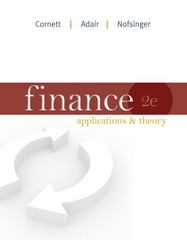Question
Additionally, assume that over each of the next two four-month periods, the share price is expected to go up by 11% or down by 10%.
Additionally, assume that over each of the next two four-month periods, the share price is expected to go up by 11% or down by 10%.
- Use a two-step binomial tree to calculate the value of an eight-month European call option using the no-arbitrage approach. [2.5 marks]
- Use a two-step binomial tree to calculate the value of an eight-month European put option using the no-arbitrage approach. [2.5 marks]
- Show whether the put-call-parity holds for the European call and the European put prices you calculated in a. and b. [1 mark]
- Use a two-step binomial tree to calculate the value of an eight-month European call option using risk-neutral valuation. [1 mark]
- Use a two-step binomial tree to calculate the value of an eight-month European put option using risk-neutral valuation. [1 mark]
- Verify whether the no-arbitrage approach and the risk-neutral valuation lead to the same results. [1 mark]
- Use a two-step binomial tree to calculate the value of an eight-month American put option. [1 mark]
- Calculate the deltas of the European put and the European call at the different nodes of the binomial three. [1 mark]
Note: When you use no-arbitrage arguments, you need to show in detail how to set up the riskless portfolios at the different nodes of the binomial tree.
Additionally, assume that over each of the next two four-month periods, the share price is expected to go up by 11% or down by 10%.
- Use a two-step binomial tree to calculate the value of an eight-month European call option using the no-arbitrage approach. [2.5 marks]
- Use a two-step binomial tree to calculate the value of an eight-month European put option using the no-arbitrage approach. [2.5 marks]
- Show whether the put-call-parity holds for the European call and the European put prices you calculated in a. and b. [1 mark]
- Use a two-step binomial tree to calculate the value of an eight-month European call option using risk-neutral valuation. [1 mark]
- Use a two-step binomial tree to calculate the value of an eight-month European put option using risk-neutral valuation. [1 mark]
- Verify whether the no-arbitrage approach and the risk-neutral valuation lead to the same results. [1 mark]
- Use a two-step binomial tree to calculate the value of an eight-month American put option. [1 mark]
- Calculate the deltas of the European put and the European call at the different nodes of the binomial three. [1 mark]
Note: When you use no-arbitrage arguments, you need to show in detail how to set up the riskless portfolios at the different nodes of the binomial tree.
Step by Step Solution
There are 3 Steps involved in it
Step: 1

Get Instant Access to Expert-Tailored Solutions
See step-by-step solutions with expert insights and AI powered tools for academic success
Step: 2

Step: 3

Ace Your Homework with AI
Get the answers you need in no time with our AI-driven, step-by-step assistance
Get Started


